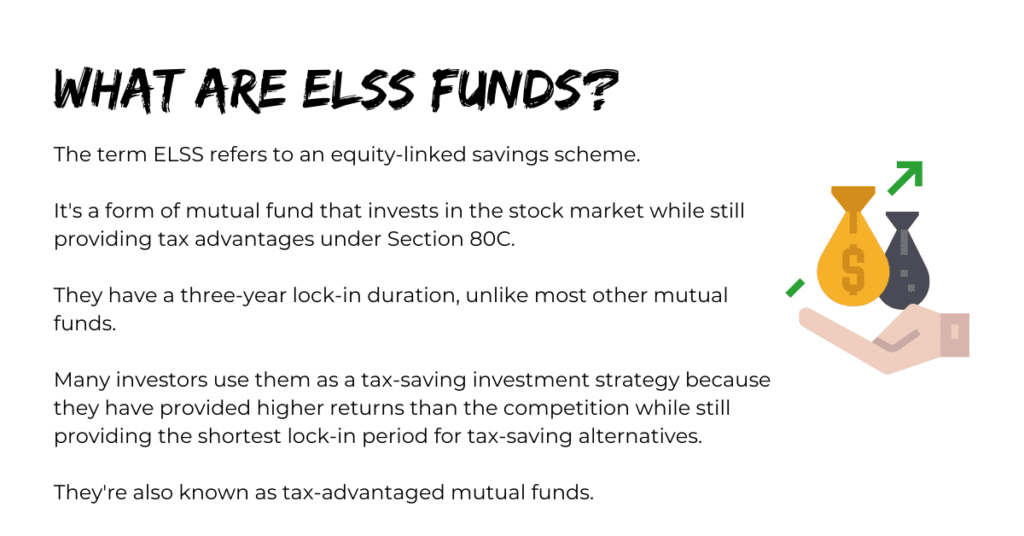What are ELSS mutual fund?
The term ELSS refers to an equity-linked savings scheme.
It’s a form of mutual fund that invests in the stock market while still providing tax advantages under Section 80C.
They have a three-year lock-in duration, unlike most other mutual funds.
Many investors use them as a tax-saving investment strategy because they have provided higher returns than the competition while still providing the shortest lock-in period for tax-saving alternatives.
They’re also known as tax-advantaged mutual funds.
Read more: What is the best Stocks Investment method?
Under Section 80C of Income tax act
Every financial year, Section 80C permits you to lower your taxable income. The maximum amount is Rs 1.5 lakhs per year.
If you earn Rs 6 lakhs a year and invest Rs 1.5 lakh under section 80C, you can deduct that amount from your total yearly income before computing tax. As a result, 6-1.5 Equals 4.5 lakhs.
As a result, while calculating income tax for that year, you will use Rs 4.5 lakhs.
As a result, the amount of tax you pay immediately decreases.
It’s worth noting that section 80C provides for various types of investments, such as bank FDs, PPFs, NPSs, and ULIPs.
Remember that the benefit is limited to a maximum of Rs 1.5 lakh.
Read more: Choosing the Best Stocks or Mutual Funds?
You won’t receive a total benefit of Rs 3 lakh if you invest Rs 1.5 lakh in a tax-saving FD and another Rs 1.5 lakh in ELSS funds.
The benefit is restricted to a maximum of Rs 1.5 lakh.
As a result, plan all of your investments in this manner.
Returning to ELSS funds now.
ELSS funds are distinctive in that they are the only investment in the stock market that provides a tax advantage.
How the investment in the ELSS fund is considered for tax saving
You must invest in an ELSS fund in the same financial year in order to get the benefits of your investment.
If you wish to take advantage of tax benefits in the fiscal year 2021-2022, for example, you must invest after April 1, 2021, and before March 31, 2022.
The maximum amount should be Rs 1.50 lakhs.
If you invest more than Rs 1.50 lakhs, you will not be eligible for any additional benefits this year or in the following financial year.
If you invest more than Rs 1.5 lakhs, nothing bad will happen. The only difference is that the sum will be locked in for three years.
You can also choose to invest monthly through a SIP or make a one-time payment via a lump sum investment (or more than one lump sum investment).
You have the option of investing in multiple ELSS funds. You may put Rs 50,000 into ELSS-1, Rs 60,000 into ELSS-2, and Rs 40,000 into ELSS-3, for example.
In a particular financial year, the total amount invested in all ELSS funds should be Rs 1.5 lakh.
However, if you invest in other tax-saving alternatives under section 80C, those must be included in the Rs 1.5 lakhs.
Tax-saving alternatives eligible under section 80C?
– NPS
– NSC
– PPF
– ULIP
– SSY
– Children’s tuition fee
And more.
So, if you’re already invested in some of these, build your ELSS portfolio accordingly.
For many families, for example, their children’s school tuition is a given – it will be paid.
So, before investing in others, you may already deduct it from your section 80C investment.
Kinds of stocks where ELSS funds invest
Large-cap funds, as you may know, only invest in large-cap equities (top 100 by size).
Only mid-cap equities are invested in mid-cap funds (101-250 by size).
Small-cap funds only invest in stocks with a market capitalization of less than Rs 5,000 crore. (251 and below by size).
These mutual funds are limited in that they must invest a significant part of their total assets in the one stock category to which they belong (large or mid or small).
That is not the case with ELSS funds.
Although ELSS funds must invest in stocks, there is no restriction or limitation on how much they must invest in large, mid, or small-cap stocks.
They have the choice to invest in whichever way they see fit.
In effect, most ELSS funds invest primarily in large-cap equities with smaller allocations to mid-cap and small-cap stocks.
Some ELSS funds put more money into mid and small-cap equities, while others don’t.
However, large-cap stocks continue to account for almost all of the investments.
The investment approach of ELSS funds is very similar to that of Flexi-cap funds.
Flexi-cap funds are free to invest in any type of company and in any style. They, too, invest mostly in large-cap equities.
Because ELSS funds invest primarily in large-cap companies, they have a proportionate risk and return profile.
They’re riskier than large-cap funds, but not as risky as mid-cap and small-cap funds.
They’ve also outperformed large-cap funds, albeit not quite as well as the best-performing mid-cap and small-cap funds.
Why invest in ELSS fund?
There is a lock-in period for all investment options under section 80C. The majority of these are years 5 and up. Ex- Tax-saving FDs have a lock-in period of 5 years whereas for PPF its 7 years.
ELSS funds have the shortest lock-in duration of three years.
ELSS funds are equity mutual funds that invest in the stock market. As a result, they have traditionally provided the greatest returns among all tax-saving investing alternatives.
Read more: 3 simple rules to make a successful Investment
You can invest as little as Rs 500 per month or in one single payment. A systematic investment plan (SIP) in one fund can be simply cancelled or paused, and a new one can be started. Please keep in mind that each payment is locked in for three years.
Best ELSS Funds to invest
One of the questions arises during Investment ‘Which ELSS is best?’ and ‘how to choose the best ELSS Fund?’
How to choose the best ELSS Fund?
- Review of Returns of the ELSS Funds
Compare the fund’s performance against that of its competitors to confirm that it has been constant over time. You can invest in the recommended funds based on these characteristics. However, keep in mind that previous success does not guarantee future performance.
- Expense Ratio
An expense ratio shows how much a financial institution costs investors to manage a portfolio, mutual fund, or exchange-traded fund (ETF).
- Financial Ratios
To evaluate a fund’s performance, use metrics such as Standard Deviation, Sharpe ratio, Sortino ratio, Alpha and Beta. A fund with a greater standard deviation and beta than one with a lower deviation and beta is riskier.
- Fund Manager
Checking the profile of a fund manager is another advantage of choosing the right mutual fund. It gives an idea about the consistency of that fund and the fund will continue to produce positive results in the future. Also, check other funds that are managed by the fund manager and their performances.
Which ELSS Fund is best?
| Mutual fund | 5 Yr. Returns | 3 Yr. Returns | Min. Invest. | Rating | Invest FREE |
|---|---|---|---|---|---|
| Quant Tax Plan-Growth | 23.72% | 30.53% | — | Invest Now | |
| Mirae Asset Tax Saver Fund – Direct Plan-Growth | 22.63% | 22.39% | ₹500 | Invest Now | |
| Canara Robeco Equity Tax Saver Fund – Direct Plan-Growth | 18.83% | 20.91% | ₹500 | Invest Now | |
| BOI AXA Tax Advantage Fund – Direct Plan-Growth | 20.94% | 20.54% | ₹500 | Invest Now | |
| DSP Tax Saver Fund – Direct Plan-Growth | 17.77% | 19.75% | ₹500 | Invest Now |
How is the lock-in period applied in the case of SIP?
Many investors mistakenly believe that the lock-in period begins on the date of the first SIP.
This isn’t correct.
Every month’s investment is considered as an individual investment in the case of SIP. As a result, the 3-year lock-in varies depending on each SIP payment.
Example: You initiated a monthly SIP of Rs 1000 in an ELSS fund, which will be charged on the 7th of each month.
You began in July of 2022.
As a result, the SIP instalment paid on July 7, 2022, will be frozen until July 4, 2025.
SIP instalments paid on August 7, 2022, will be locked in until August 7, 2025.
And so forth.
Keep in mind that the money will not be automatically withdrawn and delivered to you when the three years are up. It will continue to remain invested in it.
Only when you redeem or withdraw will you receive the funds.
It will continue to be invested if that is not the case.
If they’re satisfied with their money’s growth, many investors don’t withdraw for many years, even if it’s longer than the 3-year maximum.
Open your Demat + Trading account here:
- Zerodha- https://bit.ly/3x9FIZs
- Upstox- https://letsthinkwise.com/upstox
- 5 Paisa- https://letsthinkwise.com/5paisa


















